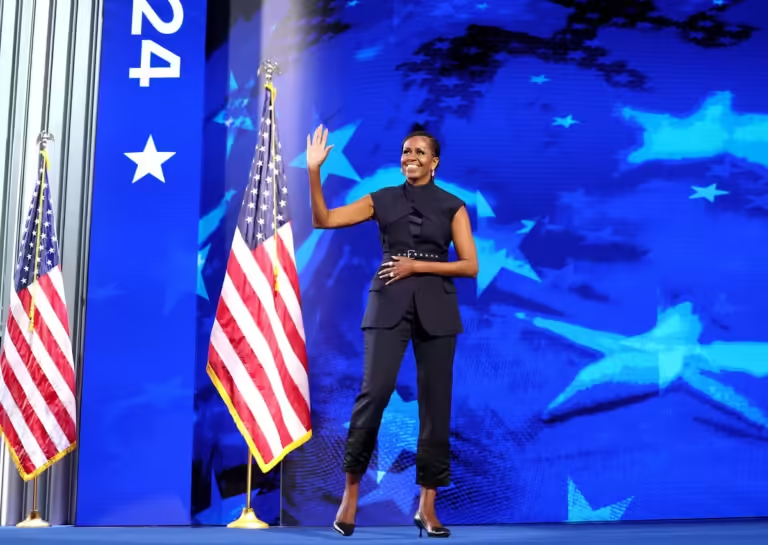On her book tour for The Light We Carry: Overcoming in Uncertain Times, Michelle Obama revealed a poignant personal insight: she had considered wearing her hair in braids as First Lady but decided against it, fearing that such a choice would overshadow her husband’s policy achievements. Fast forward to the Democratic National Convention in Chicago, and Michelle Obama made a resounding statement that America was indeed ready to see and hear her.
On the second night of the convention, Michelle Obama made a powerful entrance in a deconstructed navy suit from the American brand Monse, led by Laura Kim and Fernando Garcia, also the creative directors of Oscar de la Renta. Her look was completed with Jimmy Choo kitten heels, a belt, hoop earrings, and silver rings, while her hair was styled in braids and tied back into a ponytail. This ensemble was not just stylish but a deliberate statement—sophisticated, fierce, and effortlessly commanding.
The suit, with its asymmetrical tailoring and cinched waist, subverted traditional politico-style suiting. Its sleeveless design was particularly striking, echoing past criticisms of Obama’s own sleeveless outfits. These comments, often viewed as sexist critiques, highlighted the double standards faced by women in the public eye, particularly women of color. Obama’s choice to embrace and redefine such a look was both a fashion statement and a form of resistance.
Her speech was equally powerful, balancing harsh realities with enduring optimism. Addressing the audience with characteristic eloquence, Obama pushed back against those who sought to confine her—and Black women—into restrictive stereotypes. Her remarks were both audacious and unapologetically direct, exemplified by her cutting response to former President Donald Trump’s comments about immigrants and jobs.
The visual impact of Obama’s outfit, alongside her impassioned address, was a symbol of the progress and defiance needed in today’s political climate. It was a bold reminder that style and substance are not mutually exclusive; they can, and often do, intersect in meaningful ways. As Obama herself noted, the message is not just about appearance but about action and impact.
Kamala Harris, too, embodies this ethos through her choice of attire. Whether donning sharp suits or more casual wear like Converse kicks, Harris’s style reflects her confidence and commitment to her role. Her fashion choices, like Obama’s, are less about conforming to expectations and more about projecting strength and readiness.
Both Obama and Harris use their style to convey messages of empowerment and progress. As Obama succinctly put it, “Don’t sit around and complain about things. Do something.” For both women, this philosophy extends to their wardrobes—a blend of personal expression and political statement.
In the evolving landscape of American politics, the fashion choices of female leaders like Obama and Harris transcend mere aesthetics. They serve as symbols of strength, resilience, and a commitment to shaping a more inclusive future. Whether in a sleeveless suit or a chic, deconstructed ensemble, the message remains clear: progress is about breaking barriers and setting new standards, both in politics and in style.

